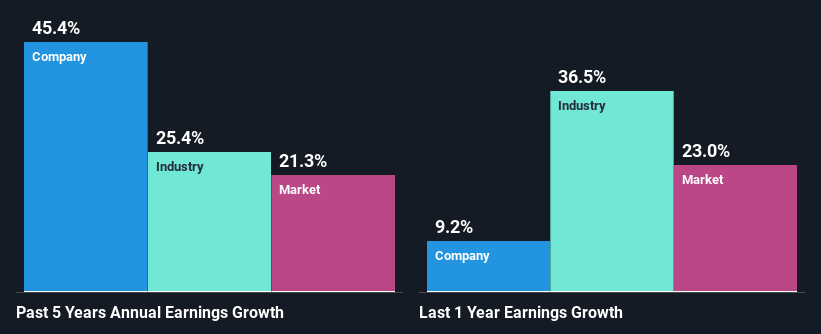- India
- /
- Electrical
- /
- NSEI:TARIL
Transformers and Rectifiers (India) Limited's (NSE:TRIL) Stock Is Going Strong: Have Financials A Role To Play?
Most readers would already be aware that Transformers and Rectifiers (India)'s (NSE:TRIL) stock increased significantly by 71% over the past three months. Given that stock prices are usually aligned with a company's financial performance in the long-term, we decided to study its financial indicators more closely to see if they had a hand to play in the recent price move. In this article, we decided to focus on Transformers and Rectifiers (India)'s ROE.
Return on equity or ROE is a key measure used to assess how efficiently a company's management is utilizing the company's capital. In simpler terms, it measures the profitability of a company in relation to shareholder's equity.
Check out our latest analysis for Transformers and Rectifiers (India)
How To Calculate Return On Equity?
Return on equity can be calculated by using the formula:
Return on Equity = Net Profit (from continuing operations) ÷ Shareholders' Equity
So, based on the above formula, the ROE for Transformers and Rectifiers (India) is:
8.4% = ₹470m ÷ ₹5.6b (Based on the trailing twelve months to March 2024).
The 'return' is the amount earned after tax over the last twelve months. Another way to think of that is that for every ₹1 worth of equity, the company was able to earn ₹0.08 in profit.
Why Is ROE Important For Earnings Growth?
We have already established that ROE serves as an efficient profit-generating gauge for a company's future earnings. Based on how much of its profits the company chooses to reinvest or "retain", we are then able to evaluate a company's future ability to generate profits. Assuming everything else remains unchanged, the higher the ROE and profit retention, the higher the growth rate of a company compared to companies that don't necessarily bear these characteristics.
Transformers and Rectifiers (India)'s Earnings Growth And 8.4% ROE
As you can see, Transformers and Rectifiers (India)'s ROE looks pretty weak. Even compared to the average industry ROE of 14%, the company's ROE is quite dismal. Despite this, surprisingly, Transformers and Rectifiers (India) saw an exceptional 45% net income growth over the past five years. Therefore, there could be other reasons behind this growth. For instance, the company has a low payout ratio or is being managed efficiently.
We then compared Transformers and Rectifiers (India)'s net income growth with the industry and we're pleased to see that the company's growth figure is higher when compared with the industry which has a growth rate of 25% in the same 5-year period.

The basis for attaching value to a company is, to a great extent, tied to its earnings growth. It’s important for an investor to know whether the market has priced in the company's expected earnings growth (or decline). By doing so, they will have an idea if the stock is headed into clear blue waters or if swampy waters await. One good indicator of expected earnings growth is the P/E ratio which determines the price the market is willing to pay for a stock based on its earnings prospects. So, you may want to check if Transformers and Rectifiers (India) is trading on a high P/E or a low P/E, relative to its industry.
Is Transformers and Rectifiers (India) Using Its Retained Earnings Effectively?
Transformers and Rectifiers (India)'s three-year median payout ratio to shareholders is 9.1%, which is quite low. This implies that the company is retaining 91% of its profits. This suggests that the management is reinvesting most of the profits to grow the business as evidenced by the growth seen by the company.
Additionally, Transformers and Rectifiers (India) has paid dividends over a period of at least ten years which means that the company is pretty serious about sharing its profits with shareholders. Our latest analyst data shows that the future payout ratio of the company is expected to rise to 17% over the next three years. Still, forecasts suggest that Transformers and Rectifiers (India)'s future ROE will rise to 31% even though the the company's payout ratio is expected to rise. We presume that there could some other characteristics of the business that could be driving the anticipated growth in the company's ROE.
Conclusion
Overall, we feel that Transformers and Rectifiers (India) certainly does have some positive factors to consider. Despite its low rate of return, the fact that the company reinvests a very high portion of its profits into its business, no doubt contributed to its high earnings growth. With that said, the latest industry analyst forecasts reveal that the company's earnings are expected to accelerate. Are these analysts expectations based on the broad expectations for the industry, or on the company's fundamentals? Click here to be taken to our analyst's forecasts page for the company.
Valuation is complex, but we're here to simplify it.
Discover if Transformers and Rectifiers (India) might be undervalued or overvalued with our detailed analysis, featuring fair value estimates, potential risks, dividends, insider trades, and its financial condition.
Access Free AnalysisHave feedback on this article? Concerned about the content? Get in touch with us directly. Alternatively, email editorial-team (at) simplywallst.com.
This article by Simply Wall St is general in nature. We provide commentary based on historical data and analyst forecasts only using an unbiased methodology and our articles are not intended to be financial advice. It does not constitute a recommendation to buy or sell any stock, and does not take account of your objectives, or your financial situation. We aim to bring you long-term focused analysis driven by fundamental data. Note that our analysis may not factor in the latest price-sensitive company announcements or qualitative material. Simply Wall St has no position in any stocks mentioned.
About NSEI:TARIL
Transformers and Rectifiers (India)
Manufactures and sells transformers in India.
Exceptional growth potential with outstanding track record.
Market Insights
Community Narratives



